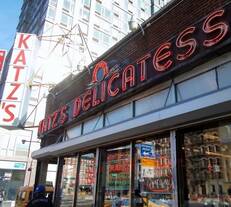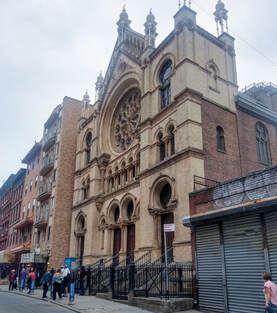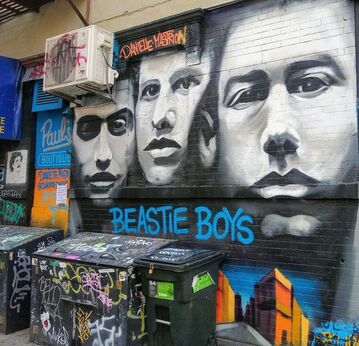Lower East Side (Manhattan) tour
More than the typical neighborhood tour: history, heritage, and the cutting edge.
 Katz's Deli, and a tower behind it Katz's Deli, and a tower behind it
Consider combining (part of) the Lower East Side with (part of) the East Village for a longer tour that encompasses what was once seen as a single neighborhood.
The Lower East Side is New York's (and the nation's) historic (but not current) immigrant neighborhood, most notably the gateway for Jews from Eastern Europe, who left an enormous imprint. (Some 80% of American Jews can trace their heritage to the Lower East Side.) A visit to the neighborhood offers many signs of that heritage--in religious institutions, social service agencies, labor monuments and union-built housing, and retail stores. But that is hardly the full picture of the neighborhood today. Indeed, the Lower East Side isn't what it used to be--as people have been saying for decades. A walk around the Lower East Side reveals complexity and contradiction, with layers of immigration (from Europe and later China) and migration (from Puerto Rico), an enormous variety of housing wrought by urban renewal, changes wrought by community organizing, and, most recently, changes wrought by gentrification. So it's unwise to focus simply on nostalgia, though significant legacy businesses--like Katz's Deli, Russ & Daughters appetizing shop, and Yonah Schimmel Knish Bakery--have bridged the neighborhood's past and present, and are worth a visit (at least if we can avoid lines). After decades of decline, the Lower East Side--at least in part--has become a "hot" neighborhood, with waves of gentrifiers following the earlier immigrants/migrants, and the artists and nonconformists who embraced the less buffed version of the neighborhood. In the evening, it's a nightlife magnet. It boasts--or suffers from--many bars and illegal weed stores. Your guide's grandparents lived and worked on the Lower East Side. He was taken to the neighborhood as a child by his parents. As an adult, he has wandered, dined, partied, and performed on the Lower East Side. Lower East Side tour highlights Eldridge Street Synagogue, restored into a museum. Eldridge Street Synagogue, restored into a museum.
We can walk briskly and thus see much more of the neighborhood than most other tours. I will try to explain how the Lower East Side exemplifies the construction of a "usable past," constructed out of books, museum exhibits, restored (and adapted) landmark buildings, and generations of collective memory. Our tour typically includes: a visit to Kossar's Bialys, the New York's famed bialy bakery (and next to the great Doughnut Plant). Also worth a stop are Yonah Schimmel's Knishery, The Pickle Guys. and the expansive Essex Street Market. We can also pop into Katz's Deli and/or Russ & Daughters, depending on crowds. (Recommendation: start early.) We can snack (or not), but this is by no means mainly a food tour. We will go past the Eldridge Street Synagogue, the first great synagogue built by Eastern European Jews, in what is today Chinatown. (They offer hour-long tours, for a fee, on most days.) We will see synagogues converted from churches, former synagogues converted to a church and a Buddhist temple, and even a functioning church that predates most immigration. We'll see housing built for the poor and working-class, some of which still serves that function, the new luxury condos that symbolize the neighborhood's gentrification and the new Essex Crossing development project that's replaced, among other things, the historic Essex Street Market, which has returned in new form. We'll view the building that once housed the Jewish Daily Forward, housing built by the activist garment workers union, and various "settlement houses" built to educate, uplift, and assimilate poor immigrants, which have evolved their robust social services for today's clientele, often Spanish- and Chinese-speaking. (In other words, people didn't pull themselves up "from their bootstraps;" they had help.) We can't avoid the performance spaces, galleries, restaurants, and nightclubs of the "new" Lower East Side, plus some clusters of street art. The sprawling Lower East Side is by no means unified; it has disparate elements geared to newcomers with more money and to longer-standing residents with less. To some degree, the spirit of the old Jewish Lower East Side--a crowded, teeming area welcoming new arrivals willing to endure a hardscrabble life--is manifested in Chinatown, which has encroached significantly on the old boundaries of the Lower East Side. But if you want to see major immigrant neighborhoods in today's New York City, welcoming people from a variety of countries, consider Jackson Heights in Queens or Sunset Park in Brooklyn. |
Distance from Midtown Manhattan: 15-25 minutes by subway/bus/taxi
Cost: see fees here Basic tour length: 2-2.5+ hours (see fees). Starting place: Varies, but typically near an F train stop (Essex Market or Houston Street). Ending place: Varies, but typically near Houston Street or Delancey Street. Highlights: Immigrant history, Jewish history, new development, shopping and snacking, galleries Before (or after) tour: Visit Tenement Museum (please book separately) After (or during) tour: Visit Katz's to eat. (Here's an entertaining article and video about Katz's.) Many snacking opportunities: knishes at Yonah Schimmel's, the Essex Street Market, Kossar's Bialys, and more. Note: Yonah Schimmel's and The Pickle Guys are certified kosher; the others are not. Potential tour extensions with me: The East Village, just to the north. Williamsburg, just across the Williamsburg Bridge in Brooklyn. Why I like leading this tour: This neighborhood is easily pigeonholed in movies or memory (or even some other available tours) as a few iconic businesses, but there's so much more to show people. A tour of the Lower East Side allows visitors to "read" the layers of in the landscape of NYC and urban history. |
